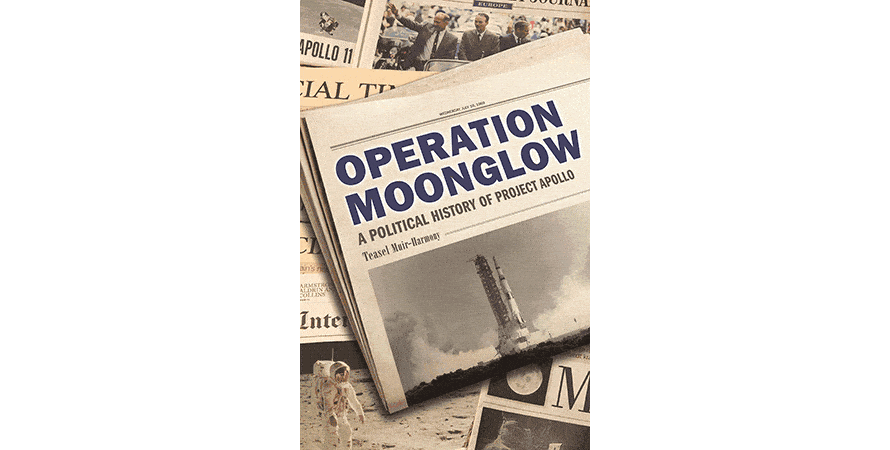Category: Nonfiction
Reviewed by: Loretta Hall
Title: Operation Moonglow: A Political History of Project Apollo
Author: Teasel Muir-Harmony
NSS Amazon link for this book
Format: Hardcover/Kindle
Pages: 384
Publisher: Basic Books
Date: November 2020
Retail Price: $32.00/$18.99
ISBN: 978-1541699878
I was a recent college graduate when Apollo 11 landed the first humans on the Moon in 1969. I remember the popularity of those U.S. astronauts as they toured other countries. In more recent years, I have read their recollections of excited crowds proclaiming “We did it!” (not “America did it”) in foreign cities. I’ve even learned a bit about Frank Borman’s diplomatic efforts with Soviet officials to share information about their lunar lander’s flight path that might have conflicted with the Apollo 11 landing.
But until reading Operation Moonglow, I hadn’t realized the extent to which international politics influenced NASA’s manned space programs. I had not known how the American government carefully choreographed the programs’ propaganda value from their very beginnings. Author Teasel Muir-Harmony’s thorough research, well documented with footnotes, establishes the book’s credibility.
As the Cold War grew out of the Second World War, so did the tenor of America’s space program. The Cold War was gaining momentum when Dwight Eisenhower was elected president in 1952, and he set the tone early on. “Eisenhower’s experience on the European front during World War II had convinced him that psychological warfare figured prominently in the Allied victory,” Muir-Harmony wrote. “When he entered the White House, he pushed for an elaborate propaganda program to contain the spread of Communism.” By August 1958, when he directed the nascent National Aeronautics and Space Administration (NASA) to develop a human space program, that attitude was part of the package.
The American strategy contrasted sharply with that of the Soviet Union, its Cold War adversary. The Soviets conducted their space program in secret, announcing only successes; and the message was “see what we Soviets have accomplished!” The Americans, however, conducted their programs in public, inviting the world to watch it all—failures and successes alike. NASA’s programs were explicitly “devoted to peaceful purposes for the benefit of all mankind.” And the message was consistently “see what humans can accomplish.” This attitude of cooperation and inclusion was specifically designed to enhance the United States’ relationships with countries, large and small, throughout the world. This was essential not only because of the competition between communism and democracy, but because America’s international image was suffering from internal racial unrest and the country’s involvement in the Vietnam War.
John Kennedy, Lyndon Johnson, and Richard Nixon, who followed Eisenhower as president during the Cold War Space Race, all embraced the existing public relations strategy. The extent to which the United States Information Agency through its United States Information Service posts in 98 countries publicized NASA events—before, during, and after—is astounding. Using general information, the staff at each post tailored the publicity to the country and culture in which it operated.
Propaganda value was the tail wagging the dog of the Apollo program. Within days of Alan Shepard’s suborbital flight, advisors told President Kennedy that “the prestige resulting from space successes was ‘part of the battle along the fluid front of the Cold War,’” Muir-Harmony wrote. “Ultimately, [James] Webb and [Robert] McNamara recommended that the United States send humans to the moon for this reason. In a May 10 [1961] meeting at the White House, Kennedy agreed.”
Appropriately, this book’s title comes from one of the Apollo program’s public relations efforts. Muir-Harmony explained that “[President] Nixon’s 1969 tour of Southeast Asia and Romania was codenamed Operation Moonglow because of the expectation that Apollo 11’s popularity and prestige would lend their sheen to the president’s new foreign policy initiatives.” That first Moon landing was deemed important enough that “In February 1969, NASA Administrator Thomas Paine established a Symbolic Activities Committee to ensure that the symbolic gestures carried out on the mission reaped the greatest political rewards for the Nixon administration.”
I give these few brief examples to entice you to read Operation Moonglow. It is a fascinating look at an aspect of the Mercury-Gemini-Apollo era that has not been widely understood.
© 2021 Loretta Hall
Please use the NSS Amazon Link for all your book and other purchases. It helps NSS and does not cost you a cent! Bookmark this link for ALL your Amazon shopping!



















